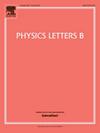Fractional-charge hadrons and leptons to tell the Standard Model group apart
IF 4.3
2区 物理与天体物理
Q1 ASTRONOMY & ASTROPHYSICS
引用次数: 0
Abstract
The gauge group of strong and electroweak interactions in Nature could be any of the four that share the same Lie algebra, with . Each of these cases allows in its spectrum for the matter fields of the SM but also for new distinctive representations, e.g. under the assumption that possesses the minimum possible hypercharge in Nature, allows for particles with a multiple of for electric charge. This letter discusses how these new possibilities in the spectrum could be used to tell the SM group apart.
求助全文
约1分钟内获得全文
求助全文
来源期刊

Physics Letters B
物理-物理:综合
CiteScore
9.10
自引率
6.80%
发文量
647
审稿时长
3 months
期刊介绍:
Physics Letters B ensures the rapid publication of important new results in particle physics, nuclear physics and cosmology. Specialized editors are responsible for contributions in experimental nuclear physics, theoretical nuclear physics, experimental high-energy physics, theoretical high-energy physics, and astrophysics.
 求助内容:
求助内容: 应助结果提醒方式:
应助结果提醒方式:


